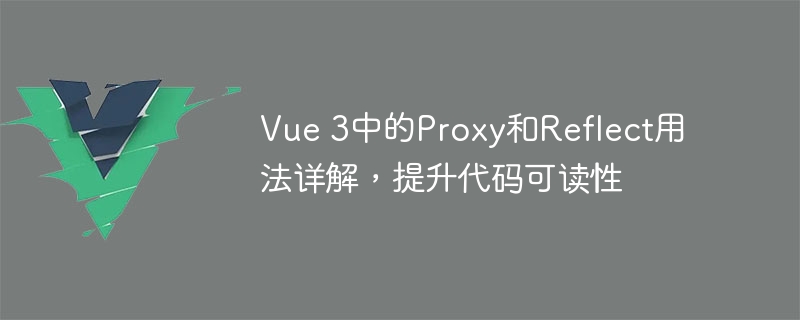

Detailed explanation of Proxy and Reflect usage in Vue 3 to improve code readability
In the Vue framework, data-driven is one of the core concepts. With the release of Vue 3, new features and syntax further enhance the readability and maintainability of code. Among them, Proxy and Reflect, as new native APIs, play an important role in data-driven development. This article will explain the usage of Proxy and Reflect in detail and show code examples to help developers better understand and apply these two features.
Proxy is a new API in ES6 for creating proxy objects. It can monitor the behavior of the target object and intercept and customize processing when the behavior occurs. Here is a simple example that shows how to use Proxy to listen for read and write operations on object properties:
const target = { name: 'Lucy' }; const handler = { get: function(target, prop) { console.log(`读取${prop}`); return target[prop]; }, set: function(target, prop, value) { console.log(`设置${prop}为${value}`); target[prop] = value; } }; const proxy = new Proxy(target, handler); console.log(proxy.name); // 输出:读取name proxy.name = 'Lily'; // 输出:设置name为Lily console.log(proxy.name); // 输出:读取name,值为Lily
In this example, we create a proxy objectproxyto Monitor the read and write operations of thetargetobject. When we read the attribute value throughproxy.name, thegetmethod will be called and output relevant information; when we passproxy.name = 'Lily'When setting the attribute value, thesetmethod will be called and output relevant information. By using Proxy, we can easily extend and control the behavior of objects, thereby enhancing the readability and maintainability of the code.
In addition to the above examples, Proxy also provides a series of hook functions (handler trap) for intercepting various operations on objects, such ashas,deleteProperty,applyetc. Through these hook functions, we can implement more flexible interception operations to meet different needs.
Closely related to Proxy is Reflect. Reflect is a global object that provides a set of methods for operating objects. It corresponds to the interception operation of Proxy. You can use Reflect's method instead of directly operating the object, thereby enhancing the readability of the code. The following is an example that shows how to use Reflect instead of calling the object's method directly:
const target = { name: 'Lucy' }; const proxy = new Proxy(target, { set: function(target, prop, value) { if (prop === 'name') { console.log(`设置${prop}为${value}`); return Reflect.set(target, prop, value); } return false; } }); Reflect.set(proxy, 'name', 'Lily'); // 输出:设置name为Lily Reflect.set(proxy, 'age', 18); // 返回false
In this example, we intercept thesetoperation through the Proxy and use Reflect'ssetmethod to actually set the property value. In this way, we can perform more flexible processing based on interception operations, while also improving the readability of the code.
In addition to methods used to replace direct manipulation of objects, Reflect also provides some other useful methods, such ashas,deleteProperty,applywait. By using Reflect, we can express our intentions more clearly and improve the readability of the code.
In Vue 3, Proxy and Reflect are core features that enable developers to better understand and apply data-driven concepts. By using Proxy to monitor the behavior of objects and perform interception processing, and using Reflect instead of directly operating objects, we can write more readable and maintainable code. I hope this article can help developers better understand and use Proxy and Reflect, and improve code quality and development efficiency in actual development.
The above is the detailed content of Detailed explanation of Proxy and Reflect usage in Vue 3 to improve code readability. For more information, please follow other related articles on the PHP Chinese website!